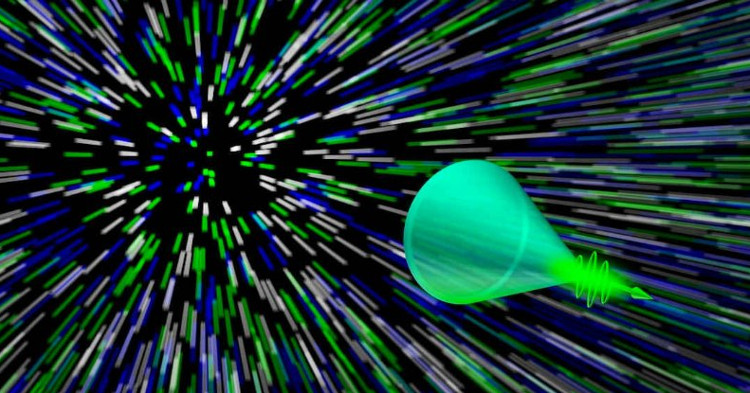For the first time, the scene broke the wall of light
When an object moves faster than sound, it creates an ultrasonic explosion. Therefore, in theory, if something moves faster than light, it will also produce a "light bomb".
As we know, when an object goes faster than the speed of sound, it will create an explosion called a supersonic explosion . Along with that, the surrounding environment at the time of the broken sound wall will also be disordered, forming a conical structure called Mach cone .
For the first time in history, researchers have filmed the same phenomenon but happened to light waves using a super-speed camera capable of capturing 1000 billion frames per second. Called the photonic explosion , a photon has surpassed the speed of light waves and created a Mach cone.
In the special theory of relativity (or special relativity), published in 1905, Albert Einstein said that no matter in the universe could move faster than the speed of light (299,792 km / s). ) in a vacuum. So how can photonic explosion happen?

Simulation image of Mach optical cone creation process.(Image source: Newscientist).
Some physicists hypothesize about " faster than light" possibilities or that an unusually distorted area of space-time could allow matter to reach a faster rate. light that cannot be reached under normal conditions.
In the laboratory, scientists have slowed down the speed of light by using a number of specific materials. While keeping a single photon moving at a normal speed. This is the method by which scientists create the phenomenon of Mach optics.
In this experiment, a group of researchers led by optical engineer Jinyang Liang of the University of Washington created a channel made of silicon rubber and aluminum oxide powder. The space in the canal is filled with a layer of mist made from dry ice powder. And then the scientists fired at a laser pulse with a frequency of 7 parts per trillion seconds. Light photons will be reflected and emitted in many directions by hitting dry ice particles suspended in the air.
Because light travels in silicon walls slower than in fog, the camera captures the phenomenon of Mach optics.
The Mach quang tu cone phenomenon has been studied by scientists for a long time. In fact, these light bombs still happen every day and can be observed with the naked eye. It is called Cherenkov radiation , according to Soviet scientist Pavel Alekseyevich Cherenkov, manifesting blue light in nuclear reactors. He was the first to measure it in 1934 and won the 1958 Nobel Prize in physics with his discovery.
This radiation is generated by the core of the reactor immersed in water to cool it. In water, the speed of light is only 75% of the speed of outside vacuum. Therefore, electrons generated from the reaction in the furnace will go faster in water than light in water. This process generates shock waves of light, like the case of supersonic aircraft. These shock waves are often blue, or sometimes ultraviolet rays that the naked eye cannot see.
However, in this case, the speed of electrons is only faster than the speed of light in the water, not really reaching the limit of 299,792.458m / s.
- The first aid was the right way when the accident broke and broke
- The school is mysteriously cutting Jordan off
- 'The first time he broke his forehead', broke the TV because of Nintendo Wii
- New cameras are shooting through walls
- Seeing the Great Wall from the universe: Fiction?
- The wall of gum is famous in America
- New way to filter light
- The hydrogen wall makes the sky dark at night
- The 'missing' section of the Great Wall has been revealed after four decades
- Ultra-light aircraft takes off from ... human hands
- Glowing wall stickers
- The student successfully built Wall-E Robot from the material collected at the landfill
 'Fine laughs' - Scary and painful torture in ancient times
'Fine laughs' - Scary and painful torture in ancient times The sequence of numbers 142857 of the Egyptian pyramids is known as the strangest number in the world - Why?
The sequence of numbers 142857 of the Egyptian pyramids is known as the strangest number in the world - Why? History of the iron
History of the iron What is alum?
What is alum?